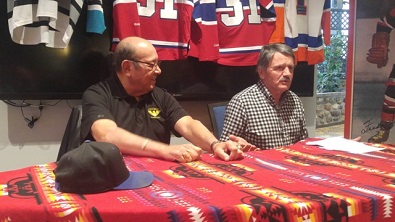Fred Sasakamoose and Chico Resch announce dates for the Fred Sasakamoose Memorial Hockey Tournament. Photo courtesy of Dean Bear.
Two icons in Saskatchewan hockey were on hand in Saskatoon Thursday to help promote the 2nd Annual Fred Sasakamoose “Chief Thunderstick” Memorial Hockey Tournament coming up at the end of April.
Fred Sasakamoose was the first ever First Nations player to play in the NHL when he skated with the Chicago Blackhawks in the later part of 1953-54. He was joined by former New York Islanders goalie Glen “Chico” Resch, who is originally from Regina.
Sasakamoose has become a role model for First Nations youth in the province and across Canada. He says that hockey was his way out of residential schools in the late 1940’s, and kids in this day and age have so many opportunities to be a success. He says that they shouldn’t have to think that there’s nothing for them outside the borders of their reserve.
“Sports is a big thing, but education is important as well. You educate yourself and you know, you have something you can fall back on. Sports can help to a great amount, but not everyone can be an athlete,” he said.
Sasakamoose says he didn’t have those same opportunities. He learned to skate on sloughs at Sandy Lake reserve (now known as Ahtahkakoop) with his grandpa watching close by. From an early age, he said he wanted to play hockey. Within a few years, he was whisked off to residential school and found he could play hockey with the team at St. Michael’s in Duck Lake. He says he worked at his game and soon enough, he was able to play junior with the Moose Jaw Canucks of the old Western Canada Junior Hockey League.
Sasakamoose played in Moose Jaw for four years and says there is one day that sticks out in his mind forever. That was the day he got a telegram that said, “Fred Sasakamoose, report immediately to the Chicago Blackhawks.” It was a dream of his to play in the NHL, and now he had that opportunity.
His first game with the big club was in Toronto at Maple Leaf Gardens, and when he stepped on the ice of the Toronto hockey palace, he said to himself, “I know my grandpa isn’t alive to see this, but I am sure he is smiling down on me today.”
He says that youth today have so many opportunities and sports gives them those chance to make a better life for themselves, whether it is at home on the reserve or in the cities. He says being part of a team builds those bonds with other youth, whether or not they are First Nation or non-Aboriginal.
“We have to be able to help our kids strive for something better instead of what has been going on with drugs, and alcohol and suicides in our communities.”
Chico Resch echoes the same sentiment. He met Sasakamoose a couple of years ago at the induction ceremonies for the Saskatchewan Sports Hall of Fame and wanted to work with him to become an ambassador for First Nations youth when it came to hockey.
“Freddy is just a guy you want to be associated with. He has become a role model for youth in this province and everyone seems to know who he is. He is a hero to so many First Nations people who have gone on to pursue their dreams,” said Resch.
Resch says he played with some great Aboriginal hockey players like Reggie Leach, Bryan Trottier, Ron Delorme and Craig Berube. He says one that thing that was synonymous with all of them was they worked their hardest all the time.
“They were committed to the team, they were tough and they had a sense of team,” he said. “And they were pretty darn funny as well, usually the funniest guys in the team.”
Even though Resch is from north central Regina, he says he says that First Nations people are proud people and they have some great heroes to gravitate to, like Sasakamoose.
“What Freddy and I trying to do is build a foundation of accountability with our youth. We want them to be a part of a bigger team, with greater goals where we can all work together, regardless of race,” Resch said.
Even though Sasakamoose is getting up in years, he still stays active by lifting weights and playing golf. He says if there is one thing he wants to live to see in his lifetime, it is Aboriginal athletes on the biggest stage.
“I want to witness the great performance of our Indians in the world of sports at the Olympics. That’s what I want.”
